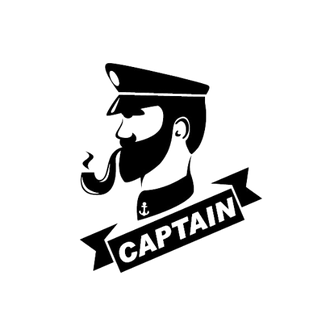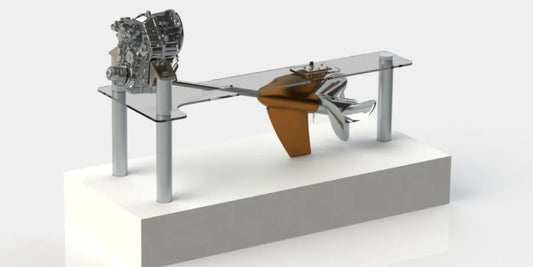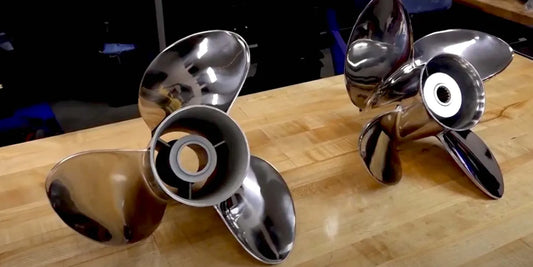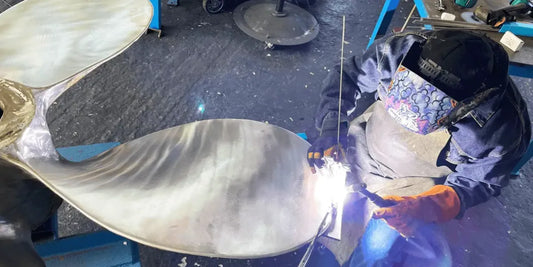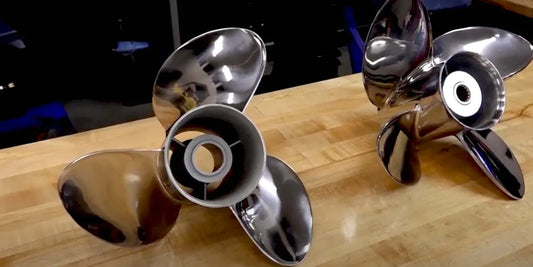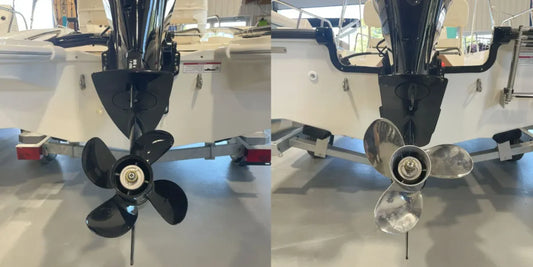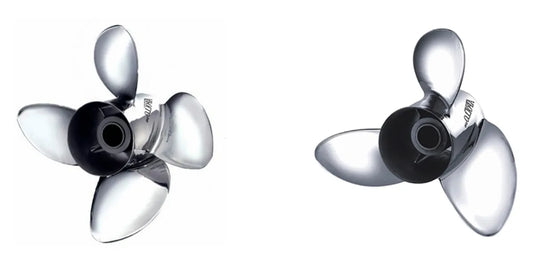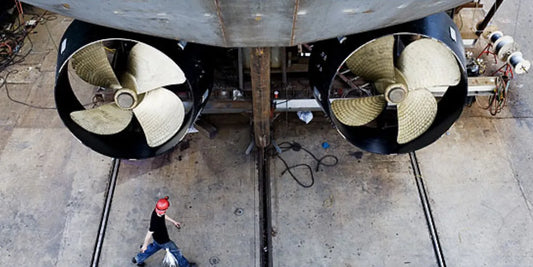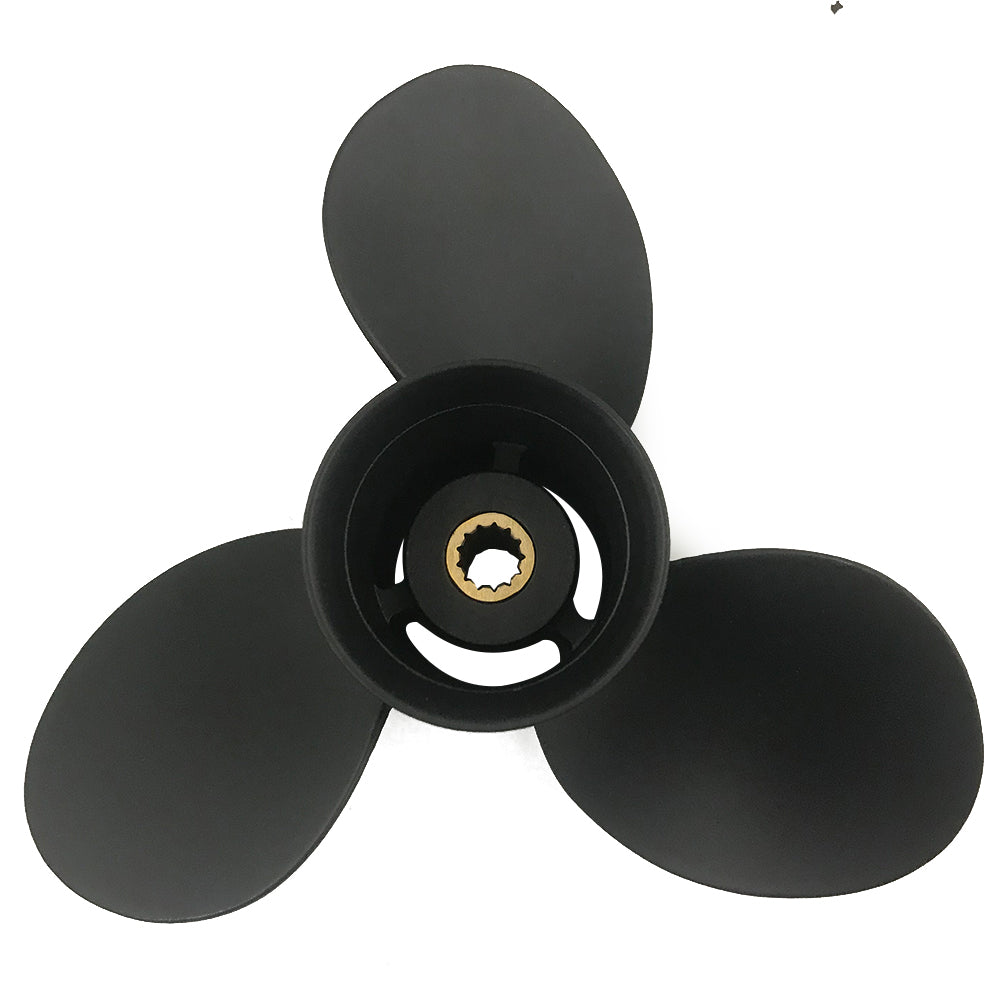When it comes to punching out all the performance of the outboard engine, the propeller can make or break it. The upgrade to a stainless steel propeller is not purely aesthetic; it is a game-changer in the eyes of boat owners striving for better efficiencies, life span, and overall performance on water. The article details the significant reasons for using stainless steel and how it elevates your boating experience. Are you after much speed, smoother handling, or a long-term investment in quality? This is your go-to guide to really understanding all the pros of making the switch for your vessel.
Understanding Stainless Steel Propellers

What is a Stainless Steel Boat Propeller?
A stainless steel boat propeller is a fg/marine product made from a heavy-duty stainless steel alloy that is considered finer to enhance the operational efficiency and reliability of a water vessel service system. Unlike aluminum or composite, stainless steel props are known for their strength and anti-corrosive properties, thus fitting almost all water piping, including saltwater. Due to the high density of the metal, thinner blades can be made without compromising durability. The thin blades mean less drag, better hydrodynamics, and increased fuel efficiency for boats that go faster or require precision handling.
This is the essence of stainless steel propellers: they can withstand worse conditions and perform. Stainless steel flexes little under high torque, thus giving stability and greater thrust. This makes them an ideal option for those who want fast acceleration, finer handling, and good control in general. Apart from that, stainless steel propellers can be manufactured in many sizes, pitches, and blade designs, allowing the user to mix and match to meet performance needs such as towing, cruising, or racing.
Because of their relatively high up-front cost, stainless steel propellers may seem like a poor return compared to their competitors. However, given their longevity and added value, stainless steel propellers boast an excellent return on investment over time. Still, stainless steel props keep cranking if they get dented by debris or underwater obstacles- well, for quite a while, since lesser-grade props can easily end up having that much life span. With maintenance costs and the fuel saved, upgrading a boat to stainless steel props is an excellent way to make the whole ship less costly and more durable.
Comparison of Stainless Steel vs. Aluminum Propellers
Performance Differences: When we talk about stainless steel versus aluminum types of propellers, the latter, being Grindstone for boats, will draw our attention to performance differences. They are known to be robust and rigid stainless steel propellers. This gives propellers less ability to change shape when under heavy load, be it speeds or bad water conditions; hence, better acceleration and top-end run-ups. Aluminum propellers, while cheaper and lighter, are less rigid than steel ones and might bend under heavy loads, reducing performance marginally in severe operating conditions.
Durability and Lifespan: One such way that sets stainless steel apart from aluminum is that stainless steel propellers are highly corrosion and wear-resistant, thus making them ideal for saltwater with debris. Their rugged nature extends their life, sometimes easily outlasting aluminum propellers by several years of maintenance. Aluminum propellers, however, tend to get dented or bent at the slightest impact from underwater obstacles, resulting in increased cases of replacements or repairs.
Cost Analysis: Stainless steel propellers are expensive upfront but offer better value over time. They offer fuel savings since better efficiency and performance translate into cost savings over time. Aluminum propellers appeal to the recreational boater or the unlucky budget-conscious boater who can least afford them if the propeller requires replacement or repair.
Ideal Applications: In the end, the choice of the propeller material will be heavily dependent upon the actual applications in view. They remain highly desirable as stainless steel propellers for performance, hardcore boating, speed, and harsh conditions. Aluminum is best for casual boaters running their boats in calm waters who must emphasize the cost side instead of the high-performance aspect.
Key Takeaways: Understanding the trade-off between stainless steel and aluminum propellers aids in making informed choices. Stainless steel is known for strength, durability, and performance, and is designed for frequent use or rare situations under rigorous conditions. On the other hand, aluminum is a low-cost option to consider in light duties and less taxing conditions. By considering factors such as durability, performance, and budget, boat owners could select the type of propeller that best fits their needs.
Key Features of Stainless Steel Propellers
A thing of beauty about stainless steel propellers and all their features is that many boaters and marine aficionados covet them. Their strength and ruggedness far supersede those of aluminum propellers, rendering them capable of standing tough against all water conditions, collateral damage, and prolonged wear and tear. Such characteristics equally translate to better performance as these materials allow for intricate blade designs, thus attaining optimum propulsion and fuel efficiency.
Thanks to the chromium alloy, stainless steel is also die-hard corrosion and rust-resistant in salty waters. Thus, stainless steel is good for coastal and offshore boating. Furthermore, stainless steel propellers are highly polished, which reduces drag and makes them more effective. The initial purchase price is steep, but the investment usually pays off in durability and performance. In keeping with this, stainless steel is always a dependable investment for on-water performance.
Benefits of Upgrading to Stainless Steel Propellers

Enhanced Durability and Performance
Creativity and versatility thrust stainless steel propellers into the category of the premium lot. Suppose a propeller has improved durability and has immense power to withstand the battering from underwater negativity, debris, and rocks thrown at it in shallow or choppy waters. In that case, it will be highly considered for adventurous boaters who venture into unpredictable water bodies. Another advantage of stainless steel is corrosion resistance, which extends the propeller's life, especially for those working in salt water environments, as exposure to loom elements accelerates wear. This could be seen as a perfect choice to relieve owners from possible frequent replacements.
When it comes to performance, stainless-steel-based propellers promise an excellent going-to-water experience. Thanks to their rigidity, stainless steel muffles the fluctuations aluminum experiences when effluxed; few said it could reach high efficiency while facing intense pressure. This means faster acceleration, more fuel-efficient operation, and a smoother ride. Also, the modern stainless propeller milling with very high accuracy allows more tuning according to boat and engine size. It will enable boat owners' efforts on performance tuning, depending on whether their target is high-speed cruising, watersports, or heavy-load towing. Being the best compromise between durability and performance, stainless steel propellers are one of the most valuable performance upgrades to enhance the water's reliability and fun.
Improved Fuel Efficiency
In the fuel efficiency equation, the stainless steel propeller holds a premier position from the practical perspective of the boat owner who wants to get the most out of their boat performance while bearing the fuel cost. Stainless steel imparts strength and rigidity, making the blades thinner and more precisely engineered than aluminum ones. These thinner blades help reduce drag, increasing hydrodynamic efficiency; thus, the engine has to work less to push the boat. Therefore, a more hydro-efficient boat-and-engine combination results in a smoother ride and consumes less fuel, mainly at cruising speeds where efficiency gains occur.
Furthermore, an excellent characteristic of stainless steel propellers is that they maintain shape and structural integrity even in highly adverse situations, such as traveling in heavy seas or carrying heavy loads. This ensures continued consistent and fuel-efficient performance. Research has shown that the resultant improved design and material characteristics of stainless steel produce ascertainable remunerative downsizing in fuel consumption throughout the lifetime of the propeller. For ecology-minded, very concerned about price-boat owners, these savings reduce any impact their activities might have on the environment while also providing a viable option for long-term investment, which will usher the stainless steel propeller into being paid back almost entirely through increased efficiency and performance.
Better Handling and Control
Due to their inherently acclaimed better options for maneuvering and control, stainless steel propellers are crucial for any boat owner who desires an enhancement in on-water performance. One of the main advantages is that they are stiff and strong compared to their aluminum counterparts. Stainless steel blades bend less under load or at high speeds; therefore, the propeller maintains uniform speed with accurate operation. This higher degree of stiffness corresponds to increased direct response and improved steerability, and, in conditions such as strong currents or adverse winds, gives a sharp, felt technique to nervous control.
Furthermore, clouds are sprayed to ensure the blade geometry, hydrodynamic efficiency of stainless steel propellers, and their optimization. Using superior engineering methods, the manufacturers can mold the blade's shape, rake, and cup to give maximum thrust and minimum cavitation, hence high acceleration with low casting vibration. Whether maneuvering carefully in a tight marina spot or quickly saddling up the wide-open water, stainless steel propellers give boaters enhanced handling attributes that translate into spelled-out confidence and safety.
Durability is another strong marketing point of stainless steel propellers. They remain structurally sound with time despite encountering debris or impacting against unconsolidated materials, and of course, the corrosive effects of saltwater environments. This ensures consistent performance: deterioration and deformation of blades are the two primary sources of compromised handling and control. By getting a stainless steel propeller, boaters have long-term stability and top-notch boating performance in almost every state, thus warranting a solid investment for professionals and hobbyists alike.
Choosing the Right Stainless Steel Prop for Your Boat

Factors to Consider: Pitch and Blade Design
A custom-made stainless steel propeller will require special attention to choose pitch and blade design, which is paramount for the given performance specifications of the boat. Pitch desires the translational distance through the theoretical amount of water covered on one propeller rotation. Low-pitch acceleration is good for towage or watersports, and a higher pitch lends itself to better top-end velocity for cruising or racing over long distances. Keeping it balanced will ensure that the motors on the boat harness their fuel power and are not overloaded.
Another important consideration affecting the boat's handling on water is the blade design. The number, shape, and surface area of blades influence thrust and stability. For example, the three-blade design is a popular choice for excellent performance but does not yield speed and fuel efficiency. More than four or five blades cruise better, minimize vibration, and increase grip, especially on hard or mushy places.
Better pitch and a convenient blade design will maximize performance, give better fuel economy, and create a long-lasting engine for all the activities you desire while boating. Careful consideration of the above elements will ensure a smooth time for the boater on board with all the fun memory-making experiences.
How to Select the Best Propeller for Your Outboard Engine
Selecting the right propeller for your outboard engine requires many factors to be considered to ensure that your boat works at peak performance and efficiency. Start by finding the proper propeller size or diameter and pitch. Such dimensions relate directly to how the boat travels through the water. A higher pitch equates to higher speeds but may stress the engine, while a lower pitch offers better acceleration and handling.
Materials are another primary consideration for propellers. Aluminum propellers are light and somewhat cheap and will suffice for most recreational boaters, but stainless steel is harder and performs better at high speed or in heavy-duty applications. Keep in mind also the cupping of the prop, which tends to give the blade a more consistent hold on water and so reduces cavitation.
Then comes ventilation and cavitation. Ventilation ensures that air is not sucked around the blade at high speed; cavitation appears when pressure is low on blade surfaces. It decreases efficiency and will damage the propeller with time. Hence, incorporating a prop that balances these effects helps to achieve better longevity and output.
New technologies also enable adjustable or interchangeable pitch props that allow more variation between conditions. Always check the manual of your outboard engine for recommendations from the maker regarding what propellers may be used with it, and water trials should follow to tune the chosen prop to specific uses such as towing, fishing, or water sports.
Keep these factors in mind, and depending on your style of boating, your choice will help you exploit engine efficiency, save fuel, and ultimately increase the lifespan of your outboard engine.
OEM vs. Aftermarket Stainless Steel Options
Choosing between OEM (Original Equipment Manufacturer) and aftermarket stainless steel equipment for your outboard engine requires a complete consideration of the pros and cons derived from your boating requirements.
OEM stainless steel parts are designed and produced by the same manufacturer as your outboard engine, which ensures 100 percent precision compatibility and performance. Extraordinary precautions are taken to put these parts through rigorous tests against original specifications so that you can rely on them for enhanced life and efficiency. OEMs generally have warranty coverage that gives comfort and added value if anything goes wrong. However, their cost is always higher than that of aftermarket options.
In contrast, aftermarket stainless steel options are provided by different manufacturers, who sometimes offer a more extensive range of products at competitive prices. With modern engineering, high-grade materials, and excellent manufacturing processes, many aftermarket components are now equal in durability and function to OEM parts. They are excellent choices if performance customization is desired, as some aftermarket components specialize in specific activities like high-speed operation or towing activities. In all other cases, performance and quality can vary hugely depending on which brand you are buying from, so do your due diligence, or you might end up with mismatched or poor-quality components.
Your decision on which is better depends upon priorities: What shall I do with it? How much am I willing to pay? What brand do I like? By reviewing your priorities and discussing them with a marine professional if need be, you will arrive at the stainless steel alternative that produces the best result yet guarantees your outboard engine will perform well over time.
Price Considerations for Stainless Steel Boat Propellers

Average Costs of Stainless Steel Propellers
Making an offer on stainless steel boat propellers can widely vary, depending on their size, design, and brand. The average cost range of simple stainless steel propellers is approximately $200 to $500, which applies to small to mid-sized recreational boats. Stainless steel propellers in a high-performance application can be anywhere from $600 to $1,200 or above, where maybe speed and fuel efficiency are the main criteria, or the application is highly specialized. Custom propellers or those built for truly specialized applications will lean toward the high side and can well exceed $2,000.
This price range also denotes some of the significant advantages they hold over aluminum propellers: durability, corrosion resistance, and performance, which are actualized in benefits to the boat owner in the long term. Also, top-tier companies can marshal advanced designs that maximize thrust and handling, thus earning a premium. In considering your purchase, you need to make that competitive comparison among alternatives fitting your vessel in terms of engine compatibility and use, betting on the value offered by premium material and top craft.
Value for Money: Long-term Savings
Choosing high-quality componentry for your marine application, such as propellers, has more than minute functionality attached to it- it-it is an associated cost over time down the road. Premium materials such as steel or aluminum are made to endure the hostile marine environment, grammatically presenting advanced wear resistance to corrosion and impact. The longer the life is, the fewer instances of replacement and repair will occur since their mere presence sharply cuts down maintenance costs. In addition, such modern designs help fuel economy, augmented by proper propeller selection on your boat engine, thereby saving operational costs, especially if the boat is used extensively or on long-distance trips.
Examples of modern advances that add value through greater efficiency and dependability include variable-pitch propellers and hybrid materials to strike an optimal band of performance and durability: returns on investment are more tangible for any boat owner. These studies reveal that boats fitted with premium-grade parts witness a fuel consumption decrease of up to 10-15% on average, depending on use conditions and maintenance levels. This leads to immense savings accrued over the lifespan of the component, emphasizing the importance of considering the total cost of ownership instead of merely the initial expenditure.
By opting for solutions that harmonize quality and performance, boat owners pay a little more for far better functionality, which ultimately benefits them and saves them money in the long run. Ensuring peace of mind and enhanced boating from well-crafted propellers that are made to meet specific engine and boat requirements also ultimately returns tangible cost savings over the years of use.
Customer Reviews and Recommendations
Once in a while, the customer would say that the durability and performance of a good-quality propeller are simply incomparable. Many noted improvements in fuel economy and handling, and a pleasant boating experience after investing in the most suitable propeller systems. For instance, boat owners often recite that their propellers' sharp design and compatibility with engines lowered maintenance costs and prolonged engine life.
Then, parallel to this trend is client satisfaction, orienting toward professional recommendations to accommodate a particular vessel and engine's needs. Using one of these highly specialized tools or diagnostics, or consulting an expert, a customer can be assured that their purchase will fill a special niche regarding the unique boating needs. Investing in personalized systems will imply higher expectations and the performance to meet them, giving enthusiastic boaters higher trust in the future. That further shows how the propellers they choose add to their value, along with expectations in their minds.
Popular Brands and Models of Stainless Steel Propellers

Mercury Stainless Steel Propellers
Mercury stainless steel propellers simply get my nod for tops in performance, rugged build, and versatility. They are designed for enhanced speed, smooth handling, and optimal fuel efficiency and are suitable for recreational boaters and professionals. From an engineering perspective, Mercury propellers are made to withstand the harsh marine environment while giving optimal performance, even in challenging conditions.
One of the key benefits of the Mercury stainless steel propellers is their ability to accelerate and control on the dot. Besides, they offer many models specifically designed for boat types and activities such as cruising, fishing, or water sports. For example, Mercury Enertia and Tempest Plus are in demand to provide that much-needed top-end speed and handling. Propeller choice is achieved according to your boating needs; with Mercury, choosing a model to suit you can be done intuitively.
Besides that, Mercury stainless steel propellers are fitted with the Flo-Torq hub system that absorbs impact and protects the drive system in case of a collision with debris, granting the user peace of mind and confidence in their long-term reliability. According to my knowledge, investing in a good Mercury propeller will maximize your boat's potential while enhancing the engine system's overall boating experience, fuel efficiency, and longevity.
Yamaha Propeller Options
A vast range of Yamaha propellers sits for choice on the market. Whether you want to improve speed, conserve fuel, or attain better handling, Yamaha has offered a variety of propellers to meet boating demands. They are made of strong material and employ advanced engineering to ensure performance maintenance despite marine environments.
The other prominent feature associated with Yamaha propellers is versatility. They come in different models. For example, the Reliance Series is designed for mid-range outboards and offers the best compromise between speed and fuel efficiency, while the Saltwater Series II is meant for bigger boats used in offshore applications and gives the highest levels of thrust and durability. Yamaha's technology enhancements, such as SDS (Shift Dampening System), reduce vibrations and noise during shifting for a smooth and quiet ride.
Eventually, you will discover that choosing a Yamaha propeller allows you to customize your boating experience to your needs. Yamaha propellers provide boaters with a tested and high-performing solution for maximizing engine efficiency or boat performance. With a Yamaha propeller, you can be sure of better handling, durability, and great times on the water.
Top Choices for 4-Blade Stainless Steel Props
Choosing the best 4-blade stainless steel propellers, I look for a balance among exceptional performance, durability, and efficiency. The Yamaha Reliance series is among my favorites in this regard. Designed for midrange outboard engines, they give a private touch in an aura of speed on acceleration and top-end capacities. And this is one of the pros of this series-about 90 miles of conservation in a day from a nice smooth ride ashore. Of course, the Reliance Series is designed to maintain consistent performance despite various situations, making it an almost sure candidate for any boating need.
Another option to consider is the Yamaha Saltwater Series II. Being heavier, this propeller is made for larger boats and offshore use and thus is put to the test in adverse saltwater conditions. I appreciate how its ruggedness makes it a long-lasting one. As long as it withstands challenges thrown at it by harsh elements, it must become a worthy investment! With this propeller, you will get thrust greater than any prop could deliver and an almost nonexistent grip while driving through heavy loads or tough seas. The particular design of the Saltwater Series II promotes fuel efficiency while maximizing your boat's overall performance.
If versatility and top-notch craftsmanship are sacred values, then look at the Turbo Offshore prop series from Yamaha. These propellers are tuned toward boaters who require a marriage between power and precision. Their performance is equally suited to many uses, whether cruising, fishing, or towing. Hence, buying a good four-blade stainless steel propeller is bound to be a good investment in improving the boating experience through better control, greater speed, and good reliability.
Reference Sources
- Aluminum vs Stainless Steel Prop Blog - Michigan Wheel
- How to Choose Between Aluminum and Stainless Steel Props - Mercury Marine
- Is an Aluminum or Stainless Steel Propeller Right For You? - Boat Specialists
- Aluminum vs. Stainless Steel Props: What's the Difference? - Boats.net
- Aluminum vs Steel Propellers – Which is the Ideal Boat Prop Material - Alberni Power Marine
Frequently Asked Questions (FAQs)
What is a stainless steel boat propeller product?
The stainless steel boat propeller product ensures maximum durability and efficient use of the propeller for the pleasure and commercial marine trades. Thus, propellers usually use high-quality stainless steel to resist corrosion and provide the best mechanical performance. They come in various configurations, including 3-blade and 4-blade types, depending on the different kinds of motors and boats. A propeller influences thrust, top-end speed, and efficiency; choosing the right one is essential for your needs. Many boat owners favor stainless steel over aluminum for its increased longevity and performance characteristics.
How does a stainless steel outboard prop differ from an aluminum one?
The construction and performance of the two propellers are their main differences. Stainless steel propellers, more durable than other materials, bend under stresses less or do not break and are, therefore, suitable for professional high-performance use. They are designed intelligently to provide greater thrust with better fuel efficiency. Aluminum propellers are usually cheaper but may not be fit to perform well in adverse marine conditions. Considering all factors, most would recommend a stainless steel outboard propeller if the goal is to maximize the top-end speed of a boat.
What advantages do the 3-blade and 4-blade stainless steel propellers have?
The difference in 3-blade and 4-blade stainless steel propellers can affect the vessel's performance capacity. Three-blade propellers generally provide higher top-end speed and better acceleration, thus making them a good pick for recreational motorboating. However, four blades allow for greater thrust and maneuverability, particularly in rough conditions or heavy burdens. The choice is often determined by application and type of motor. Many boaters enjoy the performance and durability advantages of stainless steel propellers in both configurations.
What does a Flo-Torq hub kit do in the propeller installation process?
It tends to be a significant element in the Flo-Torq hub kit, which helps protect the stainless steel propeller from shock damage while offering ease of installation and removal. The Flo-Torq hub kit supports numerous propeller configurations, making it a more versatile choice for any boater. Installing the Flo-Torq hub maximizes the efficiency and performance of your propellers during their entire service life. The kit also absorbs shock, thus minimizing the chance of propeller failure and extending the product's lifespan.
Which designers manufacture the highest-quality stainless steel propellers?
High-quality stainless steel propellers come from the best manufacturers for various applications and boating needs. Michigan Wheel and Solas, among the well-respected brands in the marine arena, are famous for stylish designs and durability. Commonly, these manufacturers carry an extensive selection of products, including those in outboard and sterndrive motor categories. When considering your stainless-steel propeller, look into the reputation of your manufacturer. That choice will determine your propeller's reliability and functionality over time. It pays to purchase a propeller from a renowned manufacturer with proven technology and craftsmanship.
What considerations go into a boat propeller replacement?
Several points are to be considered when changing your boat's propeller; they should be factored into achieving optimal resolution. First, analyze the kind of motor and the propeller size best suited for your application. Material also factors into the propeller's performance: stainless steel versus aluminum. In addition, thrust and top-end speed should be considered when deciding if you want the 3-blade or 4-blade version to be most suited; a manufacturer's reputation should be your final consideration for quality and lifetime. Considering these points will ultimately guide you in making an educated decision regarding your boat's performance requirements.
